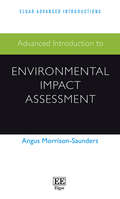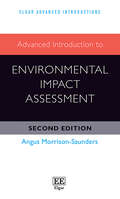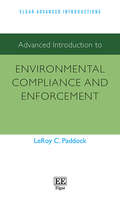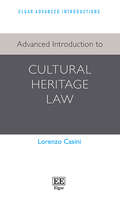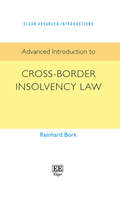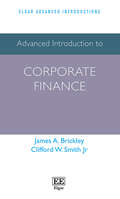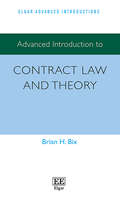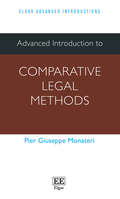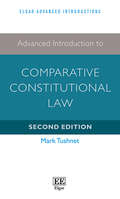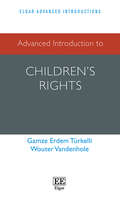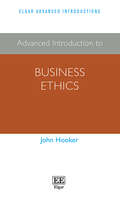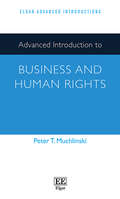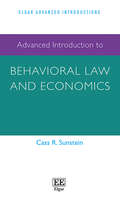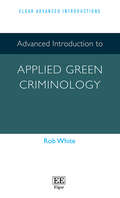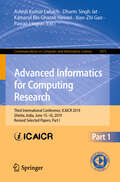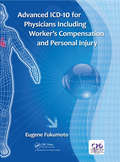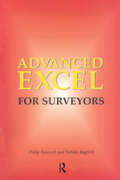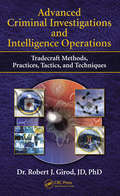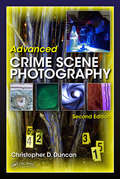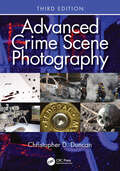- Table View
- List View
Advanced Introduction to European Union Law: Second Edition (Elgar Advanced Introductions series)
by Jacques ZillerElgar Advanced Introductions are stimulating and thoughtful introductions to major fields in the social sciences, business and law, expertly written by the world’s leading scholars. Designed to be accessible yet rigorous, they offer concise and lucid surveys of the substantive and policy issues associated with discrete subject areas.This thoroughly updated second edition of Advanced Introduction to European Union Law provides an essential overview of the diverse fields of EU law and their relevant politics. In precise but accessible language, Jacques Ziller analyses the latest developments in EU law following Brexit, the Covid-19 pandemic, and the Russia-Ukraine war, focusing on the main fields of action for the EU: the internal market, area of freedom, security and justice, and external action.Key Features:Citations of critical legal texts to aid clarity for readersInsights on the EU’s founding treaties and how they have developed over timeAnalysis of the interactions and relations between the EU and its member statesDiscussion of both the legal and political aspects of the EU’s policies and institutionsProviding an engaging entry point into the study of EU law, this Advanced Introduction will prove invaluable for students and academics in law, political science, and economics. It will also be an important resource for officials within the EU and its member states seeking a deeper understanding of the EU’s many laws and policies.
Advanced Introduction to Environmental Impact Assessment (Elgar Advanced Introductions series)
by Angus Morrison-SaundersElgar Advanced Introductions are stimulating and thoughtful introductions to major fields in the social sciences and law, expertly written by the world’s leading scholars. Designed to be accessible yet rigorous, they offer concise and lucid surveys of the substantive and policy issues associated with discrete subject areas. The Advanced Introduction to Environmental Impact Assessment explores the unifying and universal principles at the heart of Environmental Impact Assessment (EIA) wherever it may be practiced worldwide. This overview of the field by Angus Morrison-Saunders emphasizes the big ideas upon which EIA was founded and which remain central to theory and practice today. In a nutshell, EIA is essentially about thinking before acting. Key Features include: • A reminder of the fundamental ideas promoted by the pioneers and early writers about EIA • Consideration of environment and development and how the two come together in EIA • A short and concise overview of international best practice EIA principles as they apply today • Reflections on the increasing need to adopt a holistic, sustainability-oriented approach to EIA. This book is relevant to all stakeholders involved in EIA including practitioners, researchers, and teachers. It will also appeal to university students studying engineering, environmental science, geography, sustainability, and policy studies.
Advanced Introduction to Environmental Impact Assessment (Elgar Advanced Introductions series)
by Angus Morrison-SaundersElgar Advanced Introductions are stimulating and thoughtful introductions to major fields in the social sciences, business and law, expertly written by the world’s leading scholars. Designed to be accessible yet rigorous, they offer concise and lucid surveys of the substantive and policy issues associated with discrete subject areas.This updated second edition of the Advanced Introduction to Environmental Impact Assessment offers an up-to-date exploration of the current theory and practice of Environmental Impact Assessment (EIA), a crucial tool for evaluating and mitigating the impacts of development projects on the environment. Angus Morrison-Saunders provides an overview of the key concepts, principles, and methodologies of EIA, with a focus on recent developments, emerging trends, and best practices in the field.Key Features:Fresh analyses of how environment and development intersect in EIAExploration of the fundamental ideas promoted by the pioneers of EIARevised content on international best practice EIA principles and how they apply todayReflections on the increasing need to adopt a holistic, sustainability-oriented approach to EIA.With accessible style, comprehensive coverage, and a practical approach, this book is an essential resource for students, scholars, and practitioners in environmental studies, environmental governance, policy and regulation, urban planning, and related fields who want to deepen their understanding of EIA.
Advanced Introduction to Environmental Compliance and Enforcement (Elgar Advanced Introductions series)
by Lee PaddockThis Advanced Introduction provides a clear and accessible guide to the essential elements of environmental compliance and enforcement programs. It examines compliance programs designed to assist regulated entities in meeting their obligations, as well as enforcement tools designed to address non-compliance - such as administrative, civil judicial, and criminal enforcement. Offering an insightful overview of this important area, Lee Paddock highlights recent developments that are changing the way compliance and enforcement work is practiced.Key features include:a review of how the role of criminal enforcement has evolveddiscussion of traditional compliance monitoring and the role of citizen scienceexamination of the increasing importance of private environmental governance, and the role that government agencies can play in supporting these practicesexploration of the need to consider “next generation” and “smart regulation” strategies. This concise and nuanced book will be a key resource for students and scholars of environmental law and politics, criminal law and justice and international policy, as well as environmental enforcement professionals worldwide.
Advanced Introduction to Empirical Legal Research (Elgar Advanced Introductions series)
by Herbert M. KritzerElgar Advanced Introductions are stimulating and thoughtful introductions to major fields in the social sciences, business and law, expertly written by the world’s leading scholars. Designed to be accessible yet rigorous, they offer concise and lucid surveys of the substantive and policy issues associated with discrete subject areas. Herbert Kritzer presents a clear introduction to the history, methods and substance of empirical legal research (ELR). Quantitative methods dominate in empirical legal research, but an important segment of the field draws on qualitative methods, such as semi-structured interviews and observation. In this book both methodologies are explored alongside systematic data analysis. Offering an overview of the broad ELR literature, the institutions of the law, the central actors of the law, and the subjects of the law are each addressed in this highly readable account that will be essential reading for legal researchers. Key features include: • Summaries of the history of empirical legal research • A clear introduction to methods in empirical legal research • Coverage of both quantitative and qualitative methods and research • A readable guide to the impact and rationale of different methodologies. This relatively short book provides an invaluable quick introduction to ELR for students, scholars, legal professionals and policy professionals.
Advanced Introduction to Cybersecurity Law (Elgar Advanced Introductions series)
by David P. FidlerElgar Advanced Introductions are stimulating and thoughtful introductions to major fields in the social sciences, business, and law, expertly written by the world’s leading scholars. Designed to be accessible yet rigorous, they offer concise and lucid surveys of the substantive and policy issues associated with discrete subject areas. This succinct Advanced Introduction delivers insights into the pressing technological, political, and legal challenges of cybersecurity. Exploring cybersecurity threats on both a national and global scale, it provides guidance on how countries use domestic and international law to counter crime, terrorism, espionage, and armed conflict in cyberspace. Key features:Centres cybersecurity law within the internet as a technology, cyberspace as a political and governance space, and transformations in international relations over the past twenty yearsTracks how the development of policies on responding to different cyber threats, improving cyber defences, and increasing cyber deterrence affects the use and effectiveness of cybersecurity lawAnalyses whether the ongoing evolution of cyber threats changes, or should change, how countries apply domestic and international law to counter cybersecurity challenges concerning crime, terrorism, espionage, and armed conflict This Advanced Introduction is an invaluable resource for researchers and students of law, public policy, and international relations focusing on how digital technologies, the internet, and cyberspace affect world affairs. It also serves as an accessible entry point for government, corporate, and NGO staff concerned with cybersecurity law.
Advanced Introduction to Cultural Heritage Law (Elgar Advanced Introductions series)
by Lorenzo CasiniElgar Advanced Introductions are stimulating and thoughtful introductions to major fields in the social sciences, business and law, expertly written by the world’s leading scholars. Designed to be accessible yet rigorous, they offer concise and lucid surveys of the substantive and policy issues associated with discrete subject areas.Lorenzo Casini delves into the increasing globalization of cultural heritage law in this innovative and thought-provoking Advanced Introduction. Chapters build on examples of armed conflict, UNESCO World Heritage, illicit traffic and restitution, and museums. In addition to answering fundamental questions on cultural property, Casini constantly connects national and global aspects of cultural heritage law; he dissects old and contemporary dilemmas such as the public and private divide, the paradoxes of protection, the complex regulation of landscape, or the retention v. restitution approaches, and examines the future challenges of cultural heritage law in the digital age.Key Features:Balances theory and practice of cultural heritage lawEstablishes links between jurisdiction and wider legal issuesConnects domestic and global issues of cultural heritage lawPresents a rich variety of case studies and examples from different legal systemsAdopts a multidisciplinary approach connecting the law with the broader social sciencesIntroduces a comprehensive overview of international and comparative cultural heritage lawThis coherent Advanced Introduction will prove invaluable to scholars across cultural heritage law and art law. It will also be an invigorating read for practitioners, museum professionals, and lawyers in cultural heritage, art law, and intellectual property worldwide. Lastly, it highlights the general relevance and significance of cultural heritage issues in the field of law and in social sciences more broadly.
Advanced Introduction to Cross-Border Insolvency Law (Elgar Advanced Introductions series)
by Reinhard BorkElgar Advanced Introductions are stimulating and thoughtful introductions to major fields in the social sciences, business and law, expertly written by the world’s leading scholars. Designed to be accessible yet rigorous, they offer concise and lucid surveys of the substantive and policy issues associated with discrete subject areas.The Advanced Introduction to Cross-Border Insolvency Lawprovides a clear and concise overview of cross-border insolvency law with particular focus on the rules governing insolvency proceedings that occur between and across countries. Increasingly, such proceedings have an international dimension, which may involve, for example, debtors with assets abroad, foreign creditors, contractual agreements with counterparties in different jurisdictions, or companies with offices or subsidiaries in a different country. The book expertly steers the reader through the complex interactions between national and supra-national rules, international model laws, and the principles that underpin them. Key Features:Uses numerous practical examples to illustrate key conceptsProvides both in-depth information for advanced readers and accessible information for beginners in the fieldSuccinctly evaluates case law and literatureFollows a comparative law approach with a principle-based methodology in order to fully explore the most important issuesThis enlightening Advanced Introduction will be of great benefit to those studying company, commercial, and private international law, as well as to the non-specialist practitioner. Insolvency scholars will also appreciate the astute insights.
Advanced Introduction to Corporate Finance (Elgar Advanced Introductions series)
Elgar Advanced Introductions are stimulating and thoughtful introductions to major fields in the social sciences, business and law, expertly written by the world’s leading scholars. Designed to be accessible yet rigorous, they offer concise and lucid surveys of the substantive and policy issues associated with discrete subject areas. This Advanced Introduction presents the modern theories of corporate finance. Its focus on core concepts offers useful managerial insights, bolstered by recent empirical evidence, to provide a richer understanding of critical corporate financial policy decisions.Key features include:A modern approach to corporate financial theory and evidenceKey research presented in a structured mannerConcepts explained in an intuitive, example-filled manner that does not require a strong mathematics backgroundDetailed references for those wishing further reading on particular topics.Within business programs, the book offers an insightful introduction for courses on corporate finance, but also can be employed as a supplementary text in broader business courses. Experienced managers in financial functions will find the book a useful review and update of material developed since earning their degrees. Given the increasing use of cross-functional teams within the business community, the book provides a richer understanding of corporate financial policy choices for managers across a broad array of business functions.
Advanced Introduction to Contract Law and Theory (Elgar Advanced Introductions series)
by Brian H. BixElgar Advanced Introductions are stimulating and thoughtful introductions to major fields in the social sciences, business and law, expertly written by the world’s leading scholars. Designed to be accessible yet rigorous, they offer concise and lucid surveys of the substantive and policy issues associated with discrete subject areas.This comprehensive Advanced Introduction provides an overview of contract law and contemporary contract theory. Demonstrating that an understanding of theory and policy is a vital aspect of being an effective practicing lawyer, Brian H. Bix explores the various theoretical approaches which can best explain and justify contract law, arguing for greater critical attention to the connections between contract law theory, practice, and teaching.Key Features:Concise and accessible formatCombines analysis of contract doctrine and theoryIncludes detailed Restatement, UCC and case referencesAnalyses the strengths and weakness of a variety of theoretical approachesExamines contract law formation, interpretation, performance, the right of duties of third persons, and remediesThe Advanced Introduction to Contract Law and Theory will be an invaluable resource for students wanting to understand contract law and its theoretical underpinnings. It will also prove an essential guide for scholars seeking an authoritative guide to current doctrine and debates in the field of contract law.
Advanced Introduction to Comparative Legal Methods (Elgar Advanced Introductions series)
by Pier MonateriElgar Advanced Introductions are stimulating and thoughtful introductions to major fields in the social sciences, business and law, expertly written by the world’s leading scholars. Designed to be accessible yet rigorous, they offer concise and lucid surveys of the substantive and policy issues associated with discrete subject areas. Drawing on historical, normative, theoretical, and economic methodologies, Pier Giuseppe Monateri offers a fresh critical analysis of various dimensions of comparative law methods. Comprehensive and engaging with a multidisciplinary approach, this Advanced Introduction spans the fields of comparative legal studies, law and finance and global law. Key features include: uses analysis of current issues to offer a genuinely advanced perspectiveuse of theory for evaluating methods and approaches in comparative lawa comprehensive treatment of the main themes and approaches in comparative law discussions. This insightful Advanced Introduction will be an excellent resource for both law students and scholars alike. It will also be a useful guide for those working in international law, as well as law clerks and legal advisors.Professor Emeritus, Kent Law School, UK
Advanced Introduction to Comparative Constitutional Law: Second Edition (Elgar Advanced Introductions series)
by Mark TushnetElgar Advanced Introductions are stimulating and thoughtful introductions to major fields in the social sciences and law, expertly written by the world’s leading scholars. Designed to be accessible yet rigorous, they offer concise and lucid surveys of the substantive and policy issues associated with discrete subject areas. Mark Tushnet, a world-renowned scholar of constitutional law, has excelled in extending and revising his essential introduction to comparative constitutional law. Through an analysis of topics at the cutting edge of contemporary scholarship, this authoritative study investigates constitution making, forms of constitutional review, proportionality analysis and its alternatives, and the development of a new ‘transparency’ branch in constitutions around the world. Throughout, the book draws upon examples from a wide range of nations, demonstrating that the field of comparative constitutional law now truly encompasses the world. New to this revised and enlarged second edition: • Updated and extended material to encompass the developments in practice and scholarship since the original edition’s publication back in 2014 • With substantial additional attention, Tushnet analyses abusive constitutionalism, the idea of the constituent power, eternity clauses and unconstitutional amendments • Recent developments in weak- and strong-form constitutional review are given fresh analysis, as well as an expanded consideration of third generation rights. Addressing the key issues of constitutional design and structure, this second edition will serve as an excellent up-to-date resource for students and scholars of comparative constitutional law.
Advanced Introduction to Children’s Rights (Elgar Advanced Introductions series)
by Gamze Erdem Türkelli Wouter VandenholeElgar Advanced Introductions are stimulating and thoughtful introductions to major fields in the social sciences, business and law, expertly written by the world’s leading scholars. Designed to be accessible yet rigorous, they offer concise and lucid surveys of the substantive and policy issues associated with discrete subject areas.This Advanced Introduction offers a succinct yet comprehensive introduction to the multidisciplinary field of children’s rights. Inspired by the dilemma of difference in the discussion of children’s rights, chapters explore the equal rights that children share with adults as well as their differentiated and special rights.Key Features:Accessible, conceptually-grounded exploration of the contemporary children's rights debatesInclusive and multifaceted overview of children’s rights within the human rights paradigmForward looking perspectives and discussion of the future of children’s rightsApproaching the topic of children’s rights firmly within the human rights paradigm, this Advanced Introduction will be a valuable companion for students and academics interested in children's rights, human rights and international law. Legal scholars and policy-makers looking to gain insight into key areas in children's rights will also find this book an interesting read.
Advanced Introduction to Business Ethics (Elgar Advanced Introductions series)
by John HookerElgar Advanced Introductions are stimulating and thoughtful introductions to major fields in the social sciences, business and law, expertly written by the world’s leading scholars. Designed to be accessible yet rigorous, they offer concise and lucid surveys of the substantive and policy issues associated with discrete subject areas.This concise and engaging Advanced Introduction provides the conceptual tools necessary to make ethical decisions in today’s business world. John Hooker provides an objective and closely-reasoned analysis of ethical issues based on a unified conceptual framework that distils the best of ethical thought into three clearly articulated principles: the generalization, utilitarian, and autonomy principles. Key features include:examples and case studies that illustrate ethical reasoning in complex business dilemmas exploration of business ethics in relation to environmental, social, and financial sustainability factorscoverage of cross-cultural business ethics, technological unemployment, and the ethics of artificial intelligence and machine learning.This Advanced Introduction will be a valuable resource for academics and advanced students of business ethics and trust, business leadership, and corporate social responsibility. It will also be beneficial for business managers who wish to build an ethical organization, as well as technical personnel who incorporate ethics into automated systems.
Advanced Introduction to Business and Human Rights (Elgar Advanced Introductions series)
by Peter T. MuchlinskiElgar Advanced Introductions are stimulating and thoughtful introductions to major fields in the social sciences, business and law, expertly written by the world’s leading scholars. Designed to be accessible yet rigorous, they offer concise and lucid surveys of the substantive and policy issues associated with discrete subject areas.Focusing on the adoption of the UN Guiding Principles on Business and Human Rights (UNGPs) in 2011, this timely book charts the field of business and human rights, finding that corporate responsibility to respect human rights is gradually evolving into a binding legal duty in both national and international law. Following the structure of the UNGPs, Peter T. Muchlinski also covers the state duty to protect against business violations of human rights, the corporate responsibility to respect human rights and access to remedies for corporate violations of human rights.Key Features:A detailed, critical, appraisal of the UNGPs in their historical, legal and political contextsCoverage of developments in national law and policy to further the state’s duty to protect against business violations of human rightsAn interdisciplinary perspective drawing on history, law, business ethics, politics, and ideas of corporate governance with a view to introducing the field to readers with diverse specialist backgroundsCoverage of new directions for business and human rights including calls for new mandatory corporate liability laws, a legally binding international treaty and new multi stakeholder initiatives for developing business and human rights standardsThis Advanced Introduction will be a key guide for students and researchers in the fields of business and human rights, international law and business ethics, as well as lawyers and business managers who need an accessible primer to business and human rights.
Advanced Introduction to Behavioral Law and Economics (Elgar Advanced Introductions series)
by Cass R. SunsteinElgar Advanced Introductions are stimulating and thoughtful introductions to major fields in the social sciences, business and law, expertly written by the world’s leading scholars. Designed to be accessible yet rigorous, they offer concise and lucid surveys of the substantive and policy issues associated with discrete subject areas.This highly informative Advanced Introduction explores the diverse and far-reaching legal implications of some of the key findings of behavioral economics. Cass Sunstein, a leader in this field, adopts an interdisciplinary approach to examining cutting-edge topics such as air pollution and climate change; public health and safety; pandemic response; occupational safety; road safety; and contract, property, and tort law. This Advanced Introduction provides a much-needed assessment and analysis of the law as a critical domain for the use of behavioral economics, and investigates how techniques including nudging, mandates, and taxes can be used to enhance the effectiveness and improve the implementation of the law.Key Features:Explains how legal systems and governments employ behavioral economicsExplores the crucial relationship between law, behavioral economics and human welfareHighlights the use of algorithms in law and policy, considering the relationship between algorithms, noise and bias Examines key concepts from behavioral economics including sludge, present bias, loss aversion, unrealistic optimism, and anchoringThis erudite Advanced Introduction will be an essential read for legal students, academics and researchers with an interest in behavioral economics, public policy and economic psychology. Highlighting how behavioral economics interacts with various other disciplines, it will also prove valuable to professionals and practitioners working in law, medicine, education and politics.
Advanced Introduction to Applied Green Criminology (Elgar Advanced Introductions series)
by Rob WhiteElgar Advanced Introductions are stimulating and thoughtful introductions to major fields in the social sciences, business and law, expertly written by the world’s leading scholars. Designed to be accessible yet rigorous, they offer concise and lucid surveys of the substantive and policy issues associated with discrete subject areas.The Advanced Introduction to Applied Green Criminology provides a comprehensive overview of interventions and practices that contribute to environmental protection. Topics include crime prevention, environmental regulation and law enforcement, environmental forensics, greening of criminal justice institutions, and social activism. Underpinning these topics is the notion of eco-justice, which focuses on environmental justice (humans), ecological justice (ecosystems) and species justice (non-human animals and plants). Key Features:Discusses practical ways to prevent and stop environmental crimes and harmsPresents grounded examples and knowledge gained from years of experience and expertise reflecting a 'pracademic' orientationProvides insightful summaries of intervention practicesThis Advanced Introduction will be invaluable to practitioners, such as green criminologists, conservation scientists, and environmental lawyers and regulators, as well as academics and students interested in preventing, stopping, and deterring environmental crimes and harms.?
Advanced Informatics for Computing Research: Third International Conference, ICAICR 2019, Shimla, India, June 15–16, 2019, Revised Selected Papers, Part I (Communications in Computer and Information Science #1075)
by Ashish Kumar Luhach Dharm Singh Jat Kamarul Bin Ghazali Hawari Xiao-Zhi Gao Pawan LingrasThis two-volume set (CCIS 1075 and CCIS 1076) constitutes the refereed proceedings of the Third International Conference on Advanced Informatics for Computing Research, ICAICR 2019, held in Shimla, India, in June 2019. The 78 revised full papers presented were carefully reviewed and selected from 382 submissions. The papers are organized in topical sections on computing methodologies; hardware; information systems; networks; software and its engineering.
Advanced ICD-10 for Physicians Including Worker’s Compensation and Personal Injury
by Eugene FukumotoICD-10 is the 10th revision of the International Statistical Classification of Diseases and Related Health Problems (ICD), a medical classification list by the World Health Organization. It contains codes for diseases, signs and symptoms, abnormal findings, complaints, social circumstances, and external causes of injury of diseases. The code set allows more than 14,000 different codes and permits the tracking of many new diagnoses. The U.S. has used ICD-10-CM (Clinical Modification) since October, 2015. This national variant of ICD-10 was provided by the Centers for Medicare and Medicaid Services (CMS) and the National Center for Health Statistics, and the use of ICD-10-CM codes are now mandated for all inpatient medical reporting requirements. This book is for physicians, practice managers and all others who need learn ICD-10. It’s designed for the clinician to learn how to put their diagnosis into a code and not rely on staff or computer software programs to decide it form them. ICD-10 is a complex system of coding and Medicare and third party insurers have been lenient giving providers a year to get used to the coding system. As a result, physicians and their staff have become very complacent regarding proper coding. However, Medicare and third party insurers will soon begin to deny claims which are not coded correctly, which in turn will cost physician groups time and money. This book focuses on Worker’s Compensation and Personal Injury, a very large segment of the healthcare industry and is a new area to ICD-10. The diagnosis coding for injuries is much different than for Medicare or group insurance and unless the physicians and their staff learn how to use it properly, they risk losing income for themselves and worse, they risk losing the case for the patient.
Advanced ICD-10 for Physicians Including Worker’s Compensation and Personal Injury
by Eugene FukumotoICD-10 is the 10th revision of the International Statistical Classification of Diseases and Related Health Problems (ICD), a medical classification list by the World Health Organization. It contains codes for diseases, signs and symptoms, abnormal findings, complaints, social circumstances, and external causes of injury of diseases. The code set allows more than 14,000 different codes and permits the tracking of many new diagnoses. The U.S. has used ICD-10-CM (Clinical Modification) since October, 2015. This national variant of ICD-10 was provided by the Centers for Medicare and Medicaid Services (CMS) and the National Center for Health Statistics, and the use of ICD-10-CM codes are now mandated for all inpatient medical reporting requirements. This book is for physicians, practice managers and all others who need learn ICD-10. It’s designed for the clinician to learn how to put their diagnosis into a code and not rely on staff or computer software programs to decide it form them. ICD-10 is a complex system of coding and Medicare and third party insurers have been lenient giving providers a year to get used to the coding system. As a result, physicians and their staff have become very complacent regarding proper coding. However, Medicare and third party insurers will soon begin to deny claims which are not coded correctly, which in turn will cost physician groups time and money. This book focuses on Worker’s Compensation and Personal Injury, a very large segment of the healthcare industry and is a new area to ICD-10. The diagnosis coding for injuries is much different than for Medicare or group insurance and unless the physicians and their staff learn how to use it properly, they risk losing income for themselves and worse, they risk losing the case for the patient.
Advanced Excel for Surveyors
by Philip Bowcock Natalie BayfieldAdvanced Excel for Surveyors is the companion to the highly successful Excel for Surveyors. This volume is intended to help both students and practitioners use Mircosoft Excel™ to solve some of the more complex problems that the surveyor may come across.It explores how Visual Basic and macros can simplify and speed up repetitive tasks, fulfilling one of the basic aims of computing: “If it is repetitive teach the machine to do this for you”. The methodology of portfolio analysis is a relatively new discipline, which may be unfamiliar to many readers. The book provides an introduction to the principles and shows how Excel can help, readers may even find this of help when assessing their own personal investment portfolios. Further ideas for setting up databases; how to arrange for several surveyors to work on a single project; data analysis; and the use of charts in Reports are discussed together with further advice on security and protection.
Advanced Excel for Surveyors
by Philip Bowcock Natalie BayfieldAdvanced Excel for Surveyors is the companion to the highly successful Excel for Surveyors. This volume is intended to help both students and practitioners use Mircosoft Excel™ to solve some of the more complex problems that the surveyor may come across.It explores how Visual Basic and macros can simplify and speed up repetitive tasks, fulfilling one of the basic aims of computing: “If it is repetitive teach the machine to do this for you”. The methodology of portfolio analysis is a relatively new discipline, which may be unfamiliar to many readers. The book provides an introduction to the principles and shows how Excel can help, readers may even find this of help when assessing their own personal investment portfolios. Further ideas for setting up databases; how to arrange for several surveyors to work on a single project; data analysis; and the use of charts in Reports are discussed together with further advice on security and protection.
Advanced Criminal Investigations and Intelligence Operations: Tradecraft Methods, Practices, Tactics, and Techniques
by Robert J GirodTradecraft is a term used within the intelligence community to describe the methods, practices, and techniques used in espionage and clandestine investigations. Whether the practitioner is a covert agent for the government or an identity thief and con man, the methods, practices, tactics, and techniques are often the same and sometimes learned from
Advanced Crime Scene Photography
by Christopher D DuncanThe ability to thoroughly and properly document a crime scene through photography is a must for crime scene investigators. Regardless of the time of day, weather conditions, or confines in which a piece of evidence is concealed, photographs must be true and accurate. Capturing all the pertinent information and evidence for use during an investigati
Advanced Crime Scene Photography
by Christopher D. DuncanThe ability to thoroughly and accurately photograph a crime scene is a mandate for all investigators, regardless of the time of day, weather conditions, or confines within which a piece of evidence is concealed. Evidence is commonly found in locations that are some of the most difficult to access and photograph. Having the knowledge, wherewithal, and skills necessary to photograph evidence in less-than-accommodating environments is vital to a photographer’s effectiveness and success. Advanced Crime Scene Photography, Third Edition takes a somewhat different approach to the subject over prior editions. Rather than assuming a crime scene investigator’s or photographer’s comfort with the operation of their cameras—and a basic understanding of apertures, shutter speeds, ISO values, and basic exposure calculations—the author has added coverage to provide a thorough review of basic photographic concepts, as a refresher to readers. And, for those less familiar or otherwise new to photography, such background makes the foundational concepts more understandable for those readers who require such information to understand the more advanced techniques covered later in the book. In addition to this background coverage, an entirely new chapter has been added to provide essential guidance on how to prepare and testify in court. Anyone with a camera phone can take a photograph in perfect lighting, with the subject sitting out in the open, and already positioned for the best composition. This book provides crime scene photographers with the skills necessary to record those same beautiful photographs in adverse condition, surrounded by tragedy, utilizing all the tools available to the investigator. The greatest tool a photographer has available to them is their brain. From start to finish, the value of quality crime scene photographs cannot be overemphasized; photographers must take control of their photographic endeavors, identify the challenges, design a plan to capture the image correctly, and then execute that plan. As such Advanced Crime Scene Photograph, Third Edition is written to help photographers achieve the goal of capturing the best possible images—especially in those difficult-to-capture, real-world environments and conditions—for utilization in capture illustrative images as admissible evidence and for usage in court. All photographers need to practice their craft, whether they are actively working cases as seasoned veterans or are just beginning their careers. This book provides the knowledge and skills essential to achieve career and professional success in crime scene photography.

